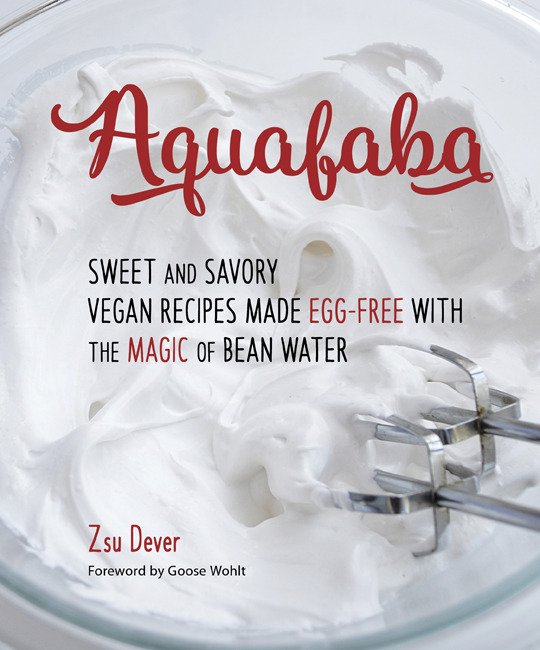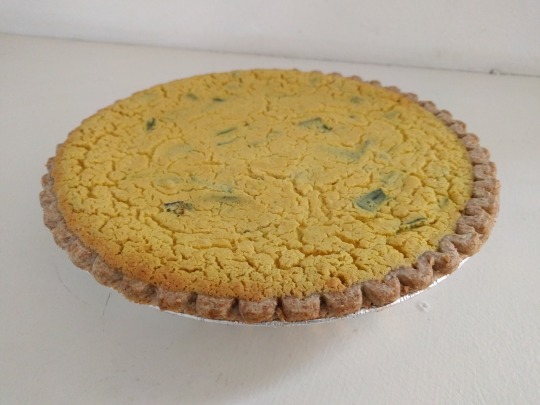
You winners know about aquafaba, right? It’s the liquid leftover from cooking chickpeas (or any other legume, really). A few years ago some folks figured out that you could whip it up like egg whites and make crazy shit like vegan meringues out of it. (Side note: Seriously, how DOES someone figure this out?)
Just as when anything important happens, the world responding by creating a Facebook group to play around with this magical unicorn tears of an ingredient. And there was much rejoicing, as it worked to make all kinds of foods like chocolate mousse and macarons and meringue that vegans had been missing like whoa.

Aquafaba meringues. Image by reid-bee / Flickr
But no one had taken the time to put everything we know about aquafaba all in one handy place…. UNTIL NOW. Zsu Dever, author of Everyday Vegan Eats and Vegan Bowls, spent 6 months experimenting with 200 POUNDS of chickpeas to learn how to write down repeatable, reliable recipes. And in October, Vegan Heritage Press released Aquafaba, which is now the best, most comprehensive resource on this crazy ingredient out there. I got a free advance copy of the book in July and have been making recipes from it ever since. Here’s the scoop.
Rachel’s Review of Aquafaba
Overall Rating: A-
Creativity: A+
Level of Difficulty: Intermediate to expert
Best for: Serious vegan cooks looking to push the envelope and make delicious dishes with this fancy new ingredient.
Dever starts the book in the obvious place: Making aquafaba itself. Until reading this section, it hadn’t occurred to me that it actually mattered how much liquid you cooked your chickpeas in if you want to use the aquafaba for cooking. Duh, but in my earliest experiments, I’d just been using whatever liquid I happened to have after making a batch, not worrying about its concentration. I didn’t necessarily need a book to tell me this, but my revelation highlights what I really like about cookbooks: Like a good class, a good cookbook walks you through from start to finish, making sure you have all the basic info you need to succeed with the recipes. This is exactly why I was craving a book about aquafaba; I didn’t want to take the time to comb through Facebook posts to figure out all the nuances I missed.
My first attempt to make aquafaba using the water/chickpea ratios Dever specifies was a burnt slow-cooker disaster, but I’m going to go ahead and blame user error on that one. Just know that you might want to up the amount of water she recommends by a cup or so if you live in a really dry place like I do (shoutout Colorado!), and that also it only takes about 5 hours to cook chickpeas from scratch in a slow-cooker, not, say, 12.
Once I got my aquafaba game going, it was time to cook! As usual, I failed to take photos of most of the recipes I made, but here’s my rendition of the Chile Relleno Quiche recipe you’ll find at the end of this post:

It looked pretty amazing and tasted that way too! It was by far the lightest, most egg-like vegan quiche I’ve had in nearly a decade of forgoing eggs, and the aquafaba totally worked. But the recipe took like 8 steps, and that’s my major concern with most of the options in the book.
Not for beginners
Even the simplest recipe, the chocolate mousse, still requires that you either make aquafaba from scratch or reduce the liquid you get from canned chickpeas, then whip the aquafaba with a stand or hand mixer, and melt chocolate, etc. Also, many recipes include relatively advanced vegan pantry ingredients like psyllium husk powder and agar flakes.
If you’re the kind of person who loves kitchen projects and the reward of working hard to make something taste amazing, then this book will add a bunch of fun new foods to your repertoire. But if you’re looking to add some quick new options to your weeknight dinner game, it won’t help much at all—these are recipes with lots of ingredients and lots of steps.
I’m sometimes happy to spend time making elaborate foods, so I really did enjoy the process of most of the meals I made. For example, the Key Lime Pie I whipped up for a party of non-vegans was a total hit, and blew my mind with how frothy and light it tasted, despite having a whole can of coconut cream in it.
Not for health nuts
That brings me to my second disappointment with an otherwise solid book: few of the recipes are very healthy, and in fact many of them are super-loaded with fat. I’ve been trying to shift my diet toward a higher concentration of protein and veggies, less simple carbs and fat, and this cookbook is not very friendly to anyone leaning that direction.
The recipe for garlicky Lebanese Toom Sauce, for example, uses 2 cups of canola oil to make 2 ¼ cups sauce. The Pound Cake uses 2 sticks of nondairy butter. At least half the book, maybe more, is about sugar-loaded desserts or pseudo-desserts (like doughnuts, muffins, and crepes). (Side note: I learned the hard way you can’t just sub in coconut sugar for granulated in these recipes. Meringue deflates.)
If you’re rolling your eyes at me and wondering, “WTF is this lady’s problem??” then AWESOME, you’re going to love this book and you should buy it. But I guess because the egg whites aquafaba often replaces are so relatively healthy, I’d been hoping that this book would do more to expand my options of everyday foods I’d be happy to eat often, not just treats for special occasions.
Final verdict: I’m glad this book exists, and I’ll continue turning to it for inspiration. It’s especially a good fit if you love complex baking projects and have been wanting to make glorious vegan versions of desserts like lemon meringue pie and macarons. But for the average cook, it’s likely a bit advanced. I consider it a great option, but mostly for special occasions.
Recipe! Aquafaba Chile Relleno Quiche

Photo by permission of Vegan Heritage Press
This creamy, delicious quiche offers all the flavors of an excellent chiles relleno. Most poblanos are relatively mild, but if you don’t want any heat, substitute 2 large green bell peppers instead. Or, if you like more heat, add a few roasted jalapeños to the mix. (copyright © 2016 by Zsu Dever. Used by permission.)
¾ cup raw cashew pieces
¾ cup plain unsweetened nondairy yogurt
4 medium poblano chiles
¾ cup aquafaba (see Note)
¼ teaspoon cream of tartar
2 tablespoons refined coconut oil, just melted and at room temperature
½ cup plus 1 tablespoon oat flour (45 grams)
5 teaspoons nutritional yeast flakes
1 teaspoon sea salt
¼ teaspoon turmeric
¼ teaspoon garlic powder
Ground black pepper, to taste
1 (9-inch) vegan pie crust, par-baked for 12 minutes
1. Preheat the oven to 325°F. Combine the cashews and yogurt in a blender and blend until smooth, scraping the sides as needed. If using a standard blender, allow the nuts to hydrate for 10 minutes and blend again until smooth. Set aside. [Rachel’s note: You can also use tofu instead of cashews.]
2. Roast the poblanos directly over the flame of your burner or roast them in a cast iron pan. {Rachel’s note: I broiled mine and it worked pretty well] Cook until blackened and charred all over. Transfer the poblanos to a bowl, cover the bowl with a plate, and set aside to steam for 15 minutes. Peel the chiles (do not wash them) and remove the stems and seeds. Chop them into ½-inch cubes and set aside. You should have about 1 ½ cups.
3. Add the aquafaba and cream of tartar to the bowl of a stand mixer. Using a whisk, vigorously whip the aquafaba for 10 seconds. Using the balloon whip attachment, whip the aquafaba on medium power for 5 minutes. Increase the speed to medium-high and continue to whip for 11 to 13 minutes, or until it forms stiff peaks. Add the oil to the meringue in a very slow, steady stream, pouring it down the side of the bowl. This should take about 1 minute.
4. Combine the oat flour, nutritional yeast, salt, turmeric, garlic powder, and black pepper. Mix well. Add the nut mixture and mix well with a whisk. Transfer about one-half of the meringue to the oat mixture and fold with a spatula to incorporate. Transfer the rest of the meringue to the tempered batter and fold until the batter is well mixed and the meringue is deflated, adding the chopped poblanos toward the end of the folding process. Pour the batter into the par-baked pie crust and bake for 40 minutes. Increase the heat to 425°F and continue to bake until the top is golden, about 5 minutes. Chill the quiche overnight [Rachel: or less] in the refrigerator to firm up.
Makes 1 (9-inch) quiche
Note: Although aquafaba is best if homemade using the recipe provided in the book, you can use aquafaba from canned chickpeas. Use the organic, low-sodium, canned chickpeas and strain off the liquid into a measuring cup using a fine mesh strainer. Note the amount of liquid you acquired, then add it to a medium saucepan and bring to a boil. Reduce to a simmer and cook until the liquid reduces by 1/3. Cool the aquafaba completely before using.